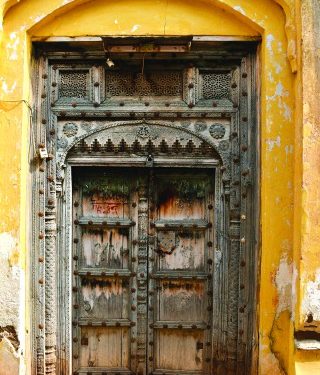
The Hindus of Nara had business in different cities of Punjab and Khyber-Pakhtunkhwa.
Zulfiqar Ali Kalhoro
Nara is a historic village in Jand tehsil of Attock district. It is located about 25 km west of Basal Chowk in Jand tehsil. The village is host to many old buildings of Muslims and Hindus alike.
Nara was an important village in the British Raj. A dispensary, post office and police outpost were built during the Raj in Nara village. The building of the police outpost, which was attached to Pind Sultan Thana (police station), is still present in Nara village. According to the Gazetteer of the Attock district 1930, Nara village’s population was more than 5,000. Moreover, it is written in the District Gazetteer that Thatta and Nara villages in Pindi Gheb tehsil were the homes of Hindu bankers with an all-India reputation.
I conducted an interview with Altaf Khan Jaffari about the history and heritage of Nara village. Altaf Khan Jaffari is a notable of the Khattar tribe of Nara village who knows the oral history of Nara village. He is 89 years old. I share some excerpts from an interview with him in this article. Altaf Khan still recalls the names of Hindus who were well-reputed bankers and businessmen of the village. He not only remembers the names of the Hindu merchants but also their stone-built havelis which were located in two mohallas of the village. He also identifies the names of the shopkeepers whose shops were located in the old Bazaar of Nara village.
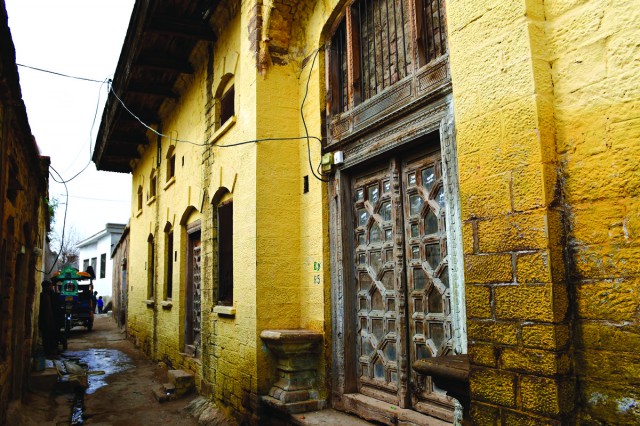
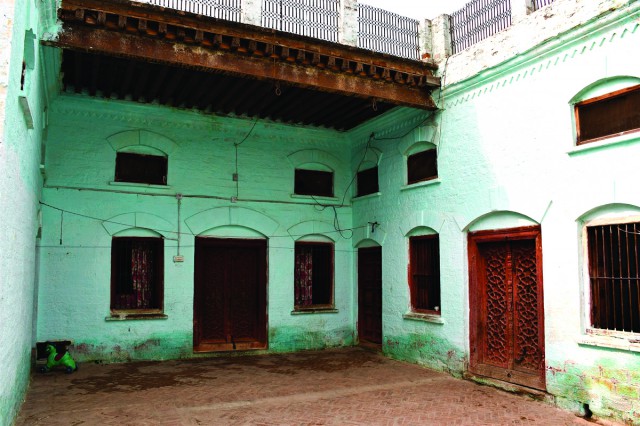
The Hindus of Nara had business in different cities of Punjab and Khyber-Pakhtunkhwa. There are still some of the havelis located in different mohallas of Nara which were built by Hindus. A posh locality of the Hindus of Nara was called Mohalla Bhagatan Wala. There were seven to eight imposing havelis of Hindus in Bhagatan Wala Mohalla also called ‘Sethian Mohalla’ – now known as Lari Ada. The most splendid and spacious haveli in the locality belonged to Dera Mal Sethi, a famous banker of the village and Pindi Gheb tehsil. He was such an influential person that the foundation stone of his mansion was laid by C.C Garbett, a British civil servant in Punjab. The haveli of Dera Mal Sethi was a four-story structure and was noted for intricate woodwork and mural paintings that decorated the interior walls. It was one of the most imposing havelis of Nara village. Today, only a single storey of the haveli has survived. The main wooden gate of the haveli still survives, which is ornately carved. The stable of Dera Mal Sethi was also located near this haveli. Just opposite the haveli of Dera Mal Sethi was located the three-story haveli of Hari Chand, another Hindu banker of Nara village. This haveli was noted for woodwork and embellishments. A single story of haveli of Hari Chand’s haveli has survived today. The wooden doors of the haveli are discernable. The main door of the haveli is the most impressive in the street today. In the same street were also located the mansions of Tarachand, Mahar Chand and Peshwari Lal. The latter banker committed suicide by jumping into the River Indus. He left a one-line suicide note which read: ‘Dil Zeest Se Bezar he Maloom nahin kyon’ (I don’t know why my heart is bored with life).
The women seldom came down from their havelis. If they wanted to visit their relatives in the same street, they used to go through wooden bridges that connected one haveli to another. These havelis were guarded by Nepali Gurkhas
The women seldom came down from their havelis. If they wanted to visit their relatives in the same street, they used to go through wooden bridges that connected one haveli to another. These havelis were guarded by Nepali Gurkhas.
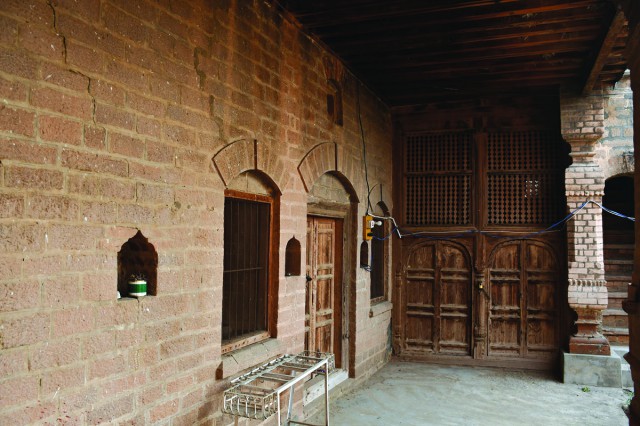
The havelis of Durana Mal, Jairam and Kishan Chand, the bankers of Nara village were also located in Bhagatan Wala Mohalla. The distinctive features of Kishan Chand haveli were wooden doors and ceiling. Both wooden doors and wooden ceiling are still extant in the haveli of Kishan Chand. The haveli of Kishan Chand has ornately carved wooden doors. The main entrance door as well as the interior ones are fabulously carved. There also used to be to Janj Ghar (Marriage Hall) in the Bhagatan Wala Mohalla but now it has disappeared. The temple was also located in the locality which also does not exist now. There were at least nine temples in Nara village, all of which have now been demolished.
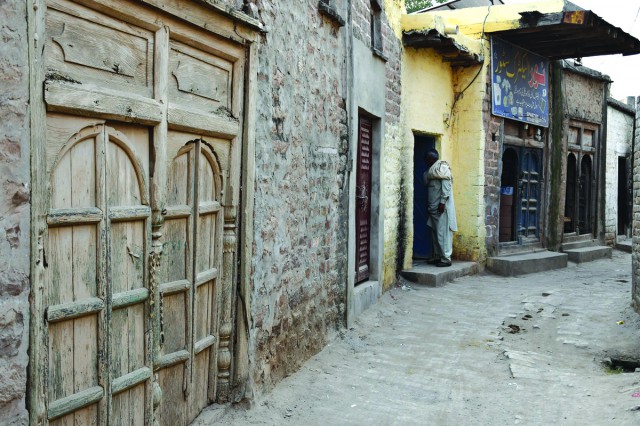
Close to the Mohalla Bhagatan Wala was a bazaar where the shops of both Hindus and Muslims were located. It was the Hindus who mainly owned shops in the bazaar.
The bazaar of Nara was noted for wooden doors and gates. Wooden doors of the majority of shops in the old bazaar are still extant. The wood carvings on doors are remarkable. There are also old bazaars in other villages in Jand tehsil, notably at Thatta and Makhad but the old bazaar of Nara has still retained the original carvings on wooden doors. According to Altaf Khan, some of the famous shopkeepers of Nara bazaar were Pandit Harnarayan, Rochi Shah, Dhunichand, Seva Ram, Seetaram etc. There are also a few havelis in bazaar area. One of the havelis noted for highly carved wooden doors is now abandoned and lies in a dilapidated condition.
The bazaar of Nara was noted for wooden doors and gates. Wooden doors of the majority of shops in the old bazaar are still extant
The havelis of Hindus were also located in Mohalla Masjid Gulab Khan. The mosque was built by Gulab Khan son of Mehar Khan Khattar in 1811 AH / 1797 AD as per an inscription on a wall of the mosque. This mosque has recently been renovated. The Khattars of Nara claim their ancestry from Abdul Rahman Khan alias Rana Khan hence are called Ranayal Khattar. Ranayals are further divided into six sub-lineages namely Kazim Khani, Allahyar Khani, Torbaz Khani, Muhbat Khani, Azam Khani and Khan Mulkial. The Khattars of Nara were influential and powerful both during the Sikh rule and the British Raj.
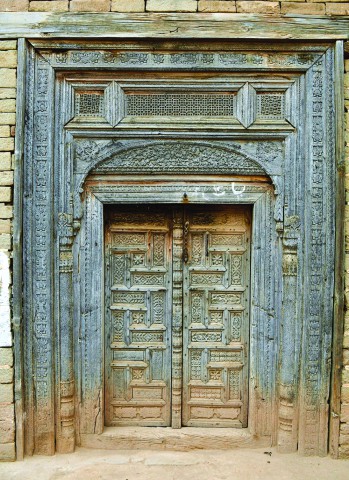
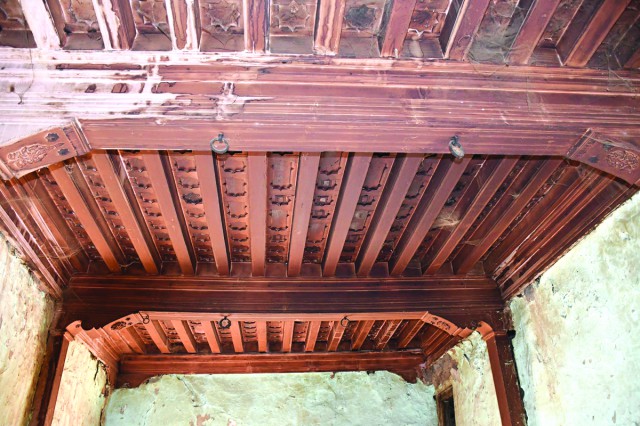
In this locality, both Hindus and Muslims lived together. The oldest mosques of Nara village which was located in this mohalla was built by Gulab Khan Khattar. Gulab Khan was from the Kazim Khani lineage of Ranyal Khattar. Kazim Khani Khattars claim their descent from Kazim Khan. The Mohalla Masjid Gulab Khan also has some of the imposing havelis of the Khattar tribe. Khudyar Khan Khattar son of Kazim Khan built an imposing haveli in Nara which had no parallel in terms of intricate woodwork in the entire village. It is the most impressive of all the havelis in the locality of Masjid Gulab Khan. The wooden ceiling and wooden doors of the haveli are simply remarkable.
There were also located a few havelis of the Hindu community in Mohalla Masjid Gulab Khan. After the haveli of Khudayar Khan Khattar, the haveli of Bodh Raj had the most impressive wooden doors. The nearby haveli of Kashiram has also beautiful carved wooden doors. There was also located the Maari of a Hindu woman named Gulabi. She had a daughter who was married to Kashiram from Pind Sultani village in then Pindi Gheb tehsil (now in Jand tehsil). According to Altaf Khan Jaffari, Gulabi had constructed the Maari for her daughter. Her son-in-law Kashiram was a teacher at the Banaras Hindu University (formerly Central Hindu College). During the vacations, he used to come to Nara village to stay in the Maari of Gulabi. Two sons of Kashiram Gangadar and Chandardar studied in Banaras and later joined government service. One of his sons became a Justice and the other joined the armed forces in Rajasthan.
Today, all of the havelis of Nara have lost their original beauty but they are still afresh and preserved in memory of Altaf Khan Jaffari.
[Excerpts from the author’s forthcoming book “History and Heritage of Pothohar”. All photos are by the author]
_________________
 Dr. Zulfiqar Ali Kalhoro is an anthropologist and author of 12 books including ‘Symbols in Stone: The Rock Art of Sindh’, ‘Perspectives on the art and architecture of Sindh’, ‘Memorial Stones: Tharparkar’ and ‘Archaeology, Religion and Art in Sindh’. He may be contacted at: zulfi04@hotmail.com
Dr. Zulfiqar Ali Kalhoro is an anthropologist and author of 12 books including ‘Symbols in Stone: The Rock Art of Sindh’, ‘Perspectives on the art and architecture of Sindh’, ‘Memorial Stones: Tharparkar’ and ‘Archaeology, Religion and Art in Sindh’. He may be contacted at: zulfi04@hotmail.com
Courtesy: The Friday Times Lahore